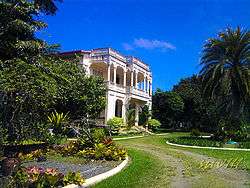Manapla
| Manapla | ||
|---|---|---|
| Municipality | ||
| Municipality of Manapla | ||
 Hacienda Santa Rosalia, Manapla | ||
| ||
| Nickname(s): The Negrosanon Top End | ||
 Map of Negros Occidental with Manapla highlighted | ||
.svg.png) Manapla Location within the Philippines | ||
| Coordinates: 10°57′N 123°07′E / 10.95°N 123.12°ECoordinates: 10°57′N 123°07′E / 10.95°N 123.12°E | ||
| Country |
| |
| Region | Western Visayas (Region VI) | |
| Province | Negros Occidental | |
| District | 2nd district of Negros Occidental | |
| Barangays | 12 (see Barangays) | |
| Government [1] | ||
| • Type | Sangguniang Bayan | |
| • Mayor | Lourdes Escalante | |
| • Electorate | 28,317 voters (2016) | |
| Area [2] | ||
| • Total | 112.86 km2 (43.58 sq mi) | |
| Population (2015 census)[3] | ||
| • Total | 54,845 | |
| • Density | 490/km2 (1,300/sq mi) | |
| Time zone | UTC+8 (PST) | |
| ZIP code | 6120 | |
| PSGC | 064518000 | |
| IDD : area code | +63 (0)34 | |
| Climate type | Tropical climate | |
| Income class | 2nd municipal income class | |
| Revenue (₱) | 132,206,986.43 (2016) | |
| Native languages |
Hiligaynon Tagalog | |
| Website |
elgu | |
Manapla, officially the Municipality of Manapla, is a 2nd class municipality in the province of Negros Occidental, Philippines. According to the 2015 census, it has a population of 54,845 people.[3]
Barangays
Manapla is politically subdivided into 12 barangays.
Demographics
| Population census of Manapla | ||
|---|---|---|
| Year | Pop. | ±% p.a. |
| 1903 | 10,123 | — |
| 1918 | 10,033 | −0.06% |
| 1939 | 19,490 | +3.21% |
| 1948 | 35,218 | +6.79% |
| 1960 | 46,809 | +2.40% |
| 1970 | 31,097 | −4.00% |
| 1975 | 38,357 | +4.30% |
| 1980 | 40,524 | +1.10% |
| 1990 | 40,095 | −0.11% |
| 1995 | 44,301 | +1.89% |
| 2000 | 49,581 | +2.44% |
| 2007 | 52,428 | +0.77% |
| 2010 | 52,687 | +0.18% |
| 2015 | 54,845 | +0.77% |
| Source: Philippine Statistics Authority[3][5][6][7] | ||
References
- ↑ "Municipality". Quezon City, Philippines: Department of the Interior and Local Government. Retrieved 31 May 2013.
- ↑ "Province:". PSGC Interactive. Quezon City, Philippines: Philippine Statistics Authority. Retrieved 12 November 2016.
- 1 2 3 Census of Population (2015). "Region VI (Western Visayas)". Total Population by Province, City, Municipality and Barangay. PSA. Retrieved 20 June 2016.
- ↑ Choose Philippines powered by Philippine Department of Tourism
- ↑ Census of Population and Housing (2010). "Region VI (Western Visayas)". Total Population by Province, City, Municipality and Barangay. NSO. Retrieved 29 June 2016.
- ↑ Censuses of Population (1903–2007). "Region VI (Western Visayas)". Table 1. Population Enumerated in Various Censuses by Province/Highly Urbanized City: 1903 to 2007. NSO.
- ↑ "Province of". Municipality Population Data. Local Water Utilities Administration Research Division. Retrieved 17 December 2016.
External links

- Philippine Standard Geographic Code
- Philippine Census Information
- Local Governance Performance Management System
This article is issued from
Wikipedia.
The text is licensed under Creative Commons - Attribution - Sharealike.
Additional terms may apply for the media files.
